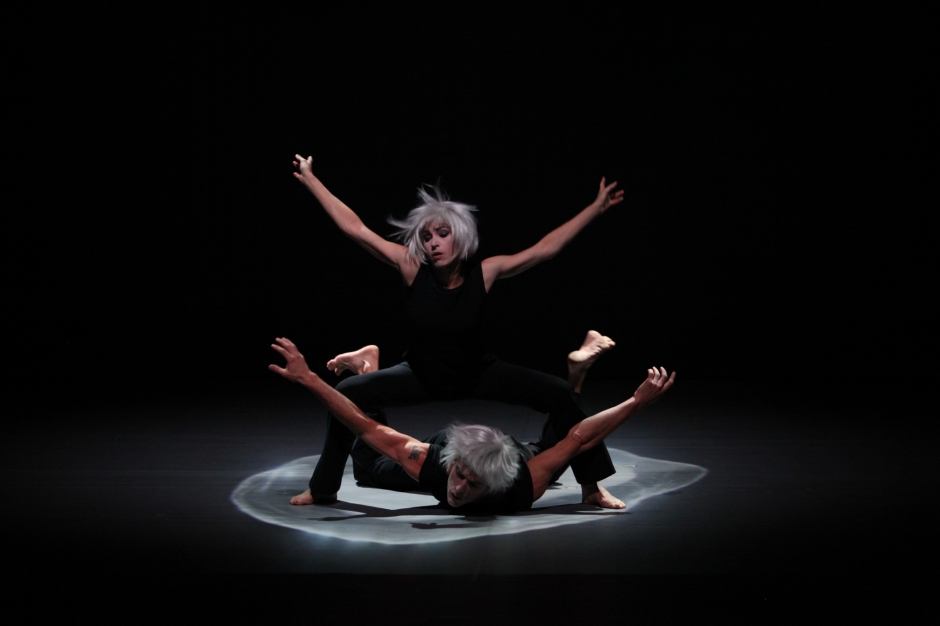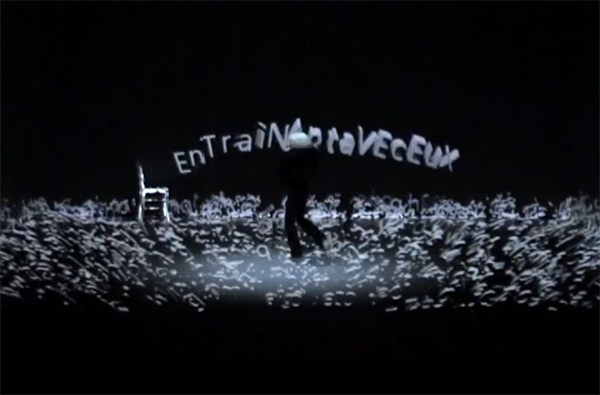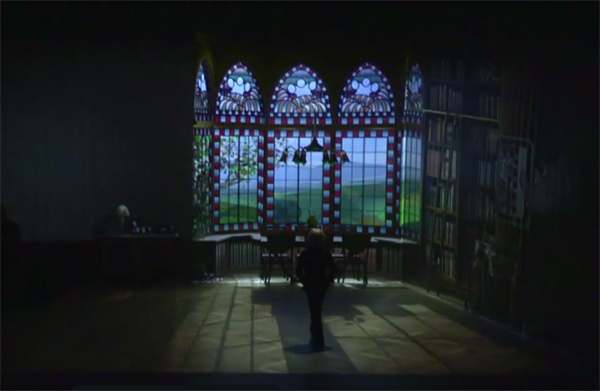Truth is in our dreams’ said Eugene Ionesco.
Mr et Mme Reve (Mr and Mrs Dream) is a theatrical dance show by Compagnie Pietragalla-Derouault, made in collaboration with a large software company called Dassault Systemes – an unusual type of collaboration, crossing art/science and art/business boundaries.
The project uses video and other digital technologies within theatre, in what is being called ‘The 3DEXPERIENCE’. As a filmmaker who has worked on theatre/video collaborations, I was interested in seeing how this particular collaboration would work out. Over the last few years I’ve seen some great use of video as part of theatre shows – the work of Forkbeard Fantasy and 1927 spring to mind – and also some poor ones. I have seen mistakes when using video which could really easily have been fixed by someone with specialist knowledge of video, which can be frustrating, especially when the ideas are good but the execution poor. With Mr And Mrs Dream, they haven’t just got an expert on board; they have the backing of a whole international software company.
The dance-theatre company Compagnie Pietragalla-Derouault was set up by former principle dancer of the Paris Opera, Marie-Claude Pietragalla and dancer Julien Derouault, a pair of extremely talented performers, extremely passionate about what they do, as we discovered in the pre-show press conference. A lot of what they said in this conference could be considered pretentious (and indeed was by some folk I chatted to afterwards), but personally I don’t mind people talking in grand terms about their work – in fact I usually like it when artists (in whatever discipline) aren’t afraid to make bold existential statements. Especially when they’re French. Julien Derouault, for example, talked about why he loves dance: ‘The past is nothing! The future is nothing! The present, that is all there is, and in dance there is only the present, you exist entirely in every moment.’
Talking about the current state of arts funding in France, he says ‘Art is not a commodity, they try and make it one but it exists separately, it is too important to be considered in these terms, and we need to fight for this.’ This is interesting in the context – considering he was doing press about a show with a huge financial commitment from a company not normally involved in the arts.
The software company Dassault Systems are also very passionate about what they do – which is mostly CGI modelling. They started with building computer-generated versions of factory parts to pre-test their engineering, and CGI testing for planes. This technology has been extended to projects such as computer generating the pyramids in order to get a better idea of how they where originally constructed – very interesting stuff in its own right. What Dassault seem to want to do is find new ways of using their technology, and have chosen to branch out into theatre. Perhaps primarily as a large PR exercise, or perhaps motivated by a drive to put the technology they have created to exciting new uses, such as its potential for creating art – or both.
Despite having attended a press conference, read the interviews with the theatre company, heard a presentation by Dassault, and being given a hefty press pack, I must confess that I sat down to watch Mr & Mrs Dream unsure exactly what I was going to see and how ‘The 3DEXPERIENCE’would look and work…
What the technology allows is for projection onto each of the three stage walls, and the floor, the projected images creating a ‘virtual set’ around the dancers, who perform in the middle of the space in what is being dubbed the ‘magic box’ There is also an element of interaction between the dancers and the animation through motion capture technology – although perhaps less than I had expected from the emphasis on this aspect in the build-up (there was so much hype that it was never going to live up to expectations). Primarily what we are talking about is computer-generated animation and some very advanced projection technology – neither of which is new, but it is scale of the use of technology that is perhaps innovative. As with all technology in art, what is important is what you do with it.
The name ‘The 3DEXPERIENCE Company’ perhaps gave me a slightly different expectation to what was presented. It’s not, for example, anything like 3D cinema (which is not necessarily a bad thing). There are no glasses, no sense of things coming at you, no extra sense of depth created by tricks of the eye. It is instead an alternative scenography, a development of the idea of a virtual set, used to create a dream landscape. Dassault describe it rather neatly as ‘a virtual unreality’.
My favourite moments in the show were actually the more simple use of projection – specifically, moments that featured the characters with back projections of a strong image. There was a moment when, as Marie-Claude Pietragalla sat in a chair, a large shadow behind her changed to look as though there were two policemen interrogating her. Yes, phantom shadows are a trick that people have been playing with for over a hundred years, but still an interesting image. Another strong images was of silhouetted large hands slowly descending towards the character. Oversized, ominous, encroaching hands is a common dream symbol and so has cropped up across many mediums. The way it was done here was in fact almost exactly as I had seen before (in a more basic lo-fi presentation) in The Devil And The Deep Blue Sea by 1927. Personally I don’t think all the elaborate technology makes it necessarily a better experience for the audience than a lo-fi equivalent – but that’s down to taste, as I usually prefer more ‘low-def’ aesthetics and approaches. I also think that more computerised imagery is usually less successful than a more hands-on process when working with surrealism – which is the realm in which the piece was operating.
Mr & Mrs Dream is inspired by Eugene Ionesco’s Theatre of the Absurd (or ‘Theatre of The Odd’ as his daughter has said he himself preferred to call it). Talking about this, Marie-Claude Pietragalla says that she always wanted to work on realising Ionesco’s vision. Ionesco himself often had problems realising his ideas – despite saying ‘Everything that we dream can be realised’. Pietragalla was interested in whether Dassault’s new technologies could help make it possible to bring Ionesco’s ideas to life. She does not see what they are doing as something entirely new but says ‘we are living in a digital era… we are just building on what has gone before’.
Interesting though Compagnie Pietragalla-Derouault’s choice to use technology to explore surrealism is, I’m not sure how successful the outcome is. Surrealism is about ‘the real’ with a twist, the real taken up a notch, or subverted. So you need to have ‘the real’ there to start with. For example I think stop-frame animation works very well for creating surreal animation because we can see a photographed object, we understand it as real, and then it starts to move, which is disturbing and exciting. But with a CGI image you never have the starting point of the real.
And I do find that surrealism works best in short bursts – Mr & Mrs Dream running at over two hours felt overlong. It does not have a clear narrative and is instead rather episodic – a common-enough contemporary theatre tactic, but if there is no linear narrative then other means have to be employed to keep the audience focused and keen to discover what happens next. Despite the strength of much of the visual imagery, the physical skill of the performers, and the interesting premise of the show, it didn’t quite add up to a great theatre show.
What it did do, though, is inspire thoughts about the potential of this technology, and that may really have been the whole point (for Dassault, at least, if not for Compagnie Pietragalla-Derouault). I would be very interested to see what comes next if this collaboration continues, or if Dassault chose to bring their technology into other artistic areas. I also hope that if they do, they continue to explore the potential of this technology to work with surrealism, because given more time to work on the possibilities, there could be some very interesting results.
To re-create dream imagery, the original surrealists of the 1920s and 30s loved using new technologies like photography and film as tools – and if they were here now I’m sure they’d be playing with new technologies such as these as much as they could. Let’s see what occurs next in this brave new world of technologies at the service of theatre.
Filmmaker Gabriel Foster Prior attended the premiere of Mr et Mme Reve in Paris June 2013 at the invitation of Dassault Systemes. The show is touring extensively in France and across Europe throughout 2014. See the company’s website for further details.



